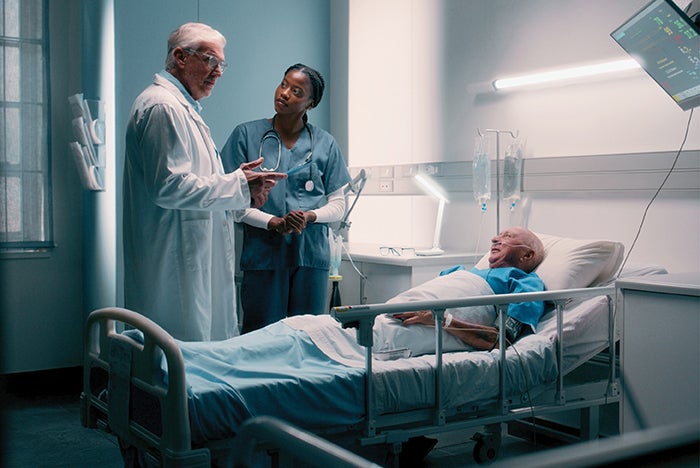Planning and technology to promote patient rest

Evidence-based design combined with advanced acoustic therapy can enhance the sleep quality, health and well-being of older adults, particularly those with dementia.
Image by Getty Images
Better access to health care and disease prevention has contributed to increased longevity. The longer people live, however, the more points of contact they are likely to have with the health care system as their vulnerability increases.
Normal age-related changes and common types of cognitive decline influence how adults perceive and interact with their environments. As the population ages, the prevalence of conditions such as dementia, Alzheimer’s and other neurologic issues impacting memory and other activities rises, increasing reliance on care partners and highlighting the need for supportive health care environments.
Health care settings of all kinds (e.g., inpatient acute, outpatient, rehabilitation and long-term care) therefore serve an increasingly older population with a broader range of physical and neurodiverse characteristics, resulting in disproportionately negative consequences.
Successful delivery
The successful delivery of services to older adults requires proactive attention to appropriate design criteria in the planning and design process, including building layout, facilities management, technology, furnishings and finishes, to name a few.
Like the professional health care providers who employ evidence-based care standards to optimize patient care outcomes, design and facilities management professionals benefit from being knowledgeable about and equipped with evidence-based design (EBD) strategies to optimize the health and well-being of all building occupants.
This is especially important for those who are most vulnerable to the effects of unsupportive environments.
Sensory environments are central to neurocognitive comfort, as the brain continuously takes cues from sights, sounds and smells as well as the tactile quality of elements that individuals encounter in their surroundings.
Studying these interactions and impacts in controlled settings is both challenging and rarely effective in providing a lived experience. However, small-scale targeted research can be very useful in recognizing the potential relationships between people and their responses to sensory stimulation.
The following research project insights were gleaned from a residential memory care setting that aimed to improve the all-important topic of sleep hygiene by investigating the impact of an auditory sleep intervention on persons with dementia.
EBD case study
Garden Spot Communities, a continuing care retirement community near Lancaster, Pa., embarked on a groundbreaking quality improvement initiative with its new Meadow View Memory Care building. This state-of-the-art, 40,000-square-foot facility designed by SFCS Architecture prioritized the application of EBD strategies to enhance the health and well-being of residents, particularly those with dementia.

Older adults with dementia exposed to sonic therapy showed improvements in behavioral symptoms that are often triggered by unfamiliar surroundings, bright light and noisy equipment.
Image by Getty Images
Traditionally designed care settings often face challenges in supporting and adapting to the evolving needs of older adults, especially when addressing the complexities of cognitive decline. Given the current absence of preventions or cures for most aging- and dementia-related changes, the Garden Spot team took an innovative approach to leverage therapeutic potential in the physical environment for sensory comfort.
The Meadow View Memory Care building is designed with two interconnected 20-person households linked by a central community “main street” and a spacious open-access courtyard. This layout reflects a thoughtful approach to creating supportive environments for dementia care, prioritizing physical and psychological self-sufficiency, safe and unrestricted access, and sensory-regulated comfort.Design elements were chosen based on extensive dementia research and innovative practices. The building incorporates circadian lighting, biophilic design and wayfinding features, all of which are grounded in EBD strategies to create supportive and engaging environments for residents. Sensory gardens, walking paths and interactive water features are integrated to offer stimulating yet soothing experiences that cater to the variety of residents’ sensory needs.
In addition to environmental design, the Meadow View building features an advanced acoustic therapy program. Internet protocol (IP) speakers were strategically placed in public, household and private spaces, including residents’ private bedrooms. This allows for the delivery of customized soundscapes designed to enhance resident well-being.
Prior research has shown a benefit in using music to moderate behavioral symptoms of those with dementia. As outlined in a 2024 scoping review protocol by Lillian Hung and colleagues, concepts like the “silent disco” and other interventions use headphones. Unfortunately, older participants may complain about the discomfort of headphone use, while staff may be burdened by equipment availability.
Most research has investigated daytime use of music, but even the studies evaluating nighttime use of music or sound typically report on sleep quality or duration as opposed to resulting behaviors.

Staff exposed to sonic therapy reported reduced burnout and improved job satisfaction, creating a more positive work environment.
Image by Getty Images
The project at Garden Spot Communities offered a unique opportunity to study a much more holistic approach of integrated design and technology. Collaborating with Composure, a New York City-based technology company specializing in evidence-based audio solutions for health, the facility developed a unique sonic (sound-based stimulus) treatment. “Sound Blanket” includes a melodic introduction and conclusion to cue both sleep and wakefulness as well as deep, soothing and low frequencies that promote rapid eye movement-based sleep, similar to “pink noise.”
Before implementing the sonic treatment throughout the building, Garden Spot Communities wanted to evaluate its effectiveness. The Center for Health Design was engaged to conduct a rigorous research study to assess resident outcomes in relation to the delivery of the sonic treatment.
The study employed a controlled before-and-after design, with one group of residents receiving the sonic intervention and a comparison group experiencing the normal sleeping conditions without the Sound Blanket.
Data collected included measures of mood, behavior, sleep quality and staff outcomes. Residents were selected based on specific criteria to ensure the intervention was appropriate and avoid potential negative effects. The sonic treatment, delivered through the ceiling-integrated IP speakers in each private resident bedroom, allowed for tailored adjustments for each individual resident.
The evaluation revealed significant positive changes in daytime alertness and reduced drowsiness among residents receiving the sonic treatment compared to the control group. The improvement in daytime drowsiness achieved statistical significance, providing robust evidence that the customized sonic treatment effectively enhanced resident alertness and sleep quality.
Additionally, the treatment group showed improvements in behavioral symptoms and overall well-being. Staff members also reported reduced burnout and improved job satisfaction, contributing to a more positive work environment.
These findings underscore the importance of integrating EBD and innovative therapies to enhance both resident care and staff well-being. The positive outcomes demonstrate that such interventions can make a meaningful impact in memory care settings and offer valuable insights for future initiatives where care is delivered to individuals who have dementia, including inpatient acute care settings.
Examining impacts
The quality improvement study at Garden Spot Communities highlights the critical role of EBD and therapeutic innovations in creating supportive environments for older adults, particularly those with dementia. By combining thoughtful architectural design and integrated technology with cutting-edge therapeutic treatments, organizations can improve quality of life for residents and patients as well as work conditions for caregivers and staff.
The benefit of studying these effects within this targeted environment is the opportunity to examine the unique impacts on individuals with neurocognitive decline within a space that has some controlled features but is also a “real-world” setting where older adults receive care. These same types of individuals also will seek services throughout the health care continuum, making these findings translatable to other care services and settings.

The case study identified statistically significant improvements in daytime alertness and reduced drowsiness, associated with enhanced sleep quality, among residents receiving the sonic treatment.
Image by Getty Images
Many aging adults have multiple age-related conditions requiring care, often resulting in a stay in an acute care setting. For example, overnight stays in hospitals are notoriously disruptive to any patient’s sleep cycle due to a range of unfamiliar sounds, alarms and activities.
The “quiet at night” score in the Hospital Consumer Assessment of Healthcare Providers and Systems (HCAHPS) survey represents a proxy for sleep quality, and the measure recognizes the importance of sleep in recovery. Unfortunately, quiet at night continues to be one of the lowest-scoring components of the HCAHPS survey.
For adults with dementia, overnight hospital stays can be especially traumatizing because of the disorientation of an unfamiliar setting, in addition to the light, noise and other features making sleep difficult. Rather than relying solely on behavioral changes of staff (e.g., decreased staff activity at night), sleep-friendly practices should incorporate the latest evidence and technologies.
Applying an appropriate soundscape to a hospital environment could have many of the same potential benefits for rest, recovery and reduced negative behavioral symptoms. Benefits to the work environment for staff could also be easily applied.
Key guidance
Reinforced through other research, some key guidance for designing aging-supportive environments includes:
- Support the needs of a diverse population. Aging- and dementia-related changes as well as a diversity of neurocognitive challenges influence perceptions and intensify interactions with surroundings, highlighting the importance of creating spaces that support these evolving needs. The design and management of health care environments must adapt to provide effective, supportive care.
- EBD is a high-impact investment. Building and renovating health care facilities represent significant financial investments that have profound impacts on patient outcomes. To optimize quality of care and return on investment outcomes, projects should capitalize upon EBD research and data to enhance patient well-being, reduce errors and increase operational efficiency.
- Leverage insights from senior care settings. Valuable insights for aging-supportive design in all health care environments can be gleaned from senior care facilities, such as nursing homes and assisted living communities. Person-centered care and related environmental design strategies encourage self-sufficiency and self-determination, including promoting familiarity, orientation, comfort and safety.
- Translate design strategies across care settings. Insights from one care setting must be carefully considered before application to other health care environments. Effective design strategies must be translated to fit the specific needs, operational goals and care philosophies of other care settings to enhance the overall patient experience and align with daily operations and workflows.
- Understand operational and organizational context. More than aesthetics, designers and facilities managers must possess a deep understanding of the ways in which design choices will interact with operational and organizational contextual forces. Integrating design with operational practices ensures that the physical environment supports the broader goals of the health care organization.
- Ensure positive sensory environments. Sensory regulated environments are crucial for all health care consumers. Sensory environments that minimize stress (e.g., mitigating excessive noise, harsh lighting and overcrowding) and maximize comfort (e.g., sonic environments, circadian lighting and visually calming spaces) significantly impact patient well-being, enhancing the overall experience and contributing to better health outcomes for all users.
Thoughtful application
Designing effective health care environments for an aging and neurodiverse population requires a thoughtful application of EBD principles. As the aging population continues to grow, non-pharmacological design approaches offer promising avenues for advancing dementia care and optimizing health care environments to meet the needs of all occupants.
By drawing insights from senior care settings, translating strategies to fit different care philosophies and understanding the operational context, health care organizations can create spaces that support health and well-being.
Additionally, focusing on positive sensory environments and protecting sensitive and vulnerable groups from negative stimuli ensures that all patients receive care in supportive and conducive surroundings. This holistic approach to health care design not only improves patient outcomes but also represents a prudent investment in the future of health care facilities.
The Center for Health Design focuses on aging environments
The Resilient Aging Environments Network (RAEN) is The Center for Health Design’s newest collaborative for executive-level leaders involved in the planning, design and operations of settings that support health, safety, longevity and resiliency for an aging population.
Launched in 2024, RAEN is modeled after The Center’s other successful environment networks — Built Environment Network, Pediatric Environment Network and the recently formed Behavioral and Mental Health Environment Network. These groups bring together diverse and forward-thinking members from health care, design and solutions organizations who want to be on and contribute to the cutting edge of change.
With the support of The Center, RAEN provides dedicated programming and facilitated opportunities to members who drive conversations and topics of interest. Networking and communication, both in person and through an online forum, provide members with year-round access to learning, sharing, innovating, problem-solving and relationship-making experiences.
As RAEN member Steve Lindsey, chief executive officer of Garden Spot Communities, the Lancaster, Pa.-based continuing care retirement community featured in the accompanying main article, says, “Senior living environments are desperate for innovation, which best occurs when bright, dedicated people come together and openly contribute to the collective genius. An innovation community like this provides a safe place where we can be inspired, challenged and supported to create transformative environments where older adults can thrive.”
RAEN provides a unique opportunity to be part of a dedicated group of professionals who are committed to shaping the future environments and the lives of older adults through thoughtful engagement and learning, with customized access to The Center’s research, education and community resources.
A limited number of RAEN memberships are available for senior-level individuals from health care facilities and design and solution provider organizations. For more information, contact The Center for Health Design or visit online.
About this article
This feature is one of a series of articles published by Health Facilities Management in partnership with The Center for Health Design.
Addie M. Abushousheh, Ph.D., EDAC, Assoc. AIA, is an organizational and environmental gerontologist and research associate at The Center for Health Design; and Migette Kaup, Ph.D, EDAC, is facilitator for The Center for Health Design’s Resilient Aging Environments Network. They can be reached at aabushousheh@healthdesign.org and mkaup@healthdesign.org.




